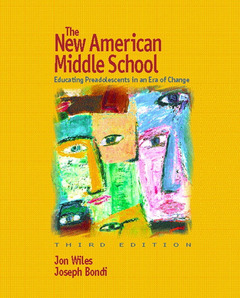The new american middle school (3rd ed )
Langue : Anglais
Auteurs : WILES Jon W., BONDI Joseph C.

(NOTE: Each chapter concludes with Summary.)
1. Rationale for a New School in the Middle.
Reform, the Third Phase. Information Is Becoming More Accessible. Origins of Intermediate Education. The Junior High School 1910-1965. The Early Middle School 1965-2000. Early Warning Signs of Failure. The Middle School Promise. The New Middle School in Transition. The Challenge of Change.
2. Today's Preadolescent Learner.
Characteristics of Emerging Adolescents and Implications for the Middle School. Needs Suggested by Growth and Development Characteristics. Emerging Adolescents in a Changing Society. Social Change: Implications for Middle School Youth. Essential Goals for New Middle School Students.
3. Effective Organizational Structures.
Team Teaching. Interdisciplinary Teaming. Flexible Modular Scheduling. Graded versus Nongraded Organization. The Middle School and Multiage Grouping. Facilities. Year-Round Schooling. Computer-Based Management Tools. Issues in Middle School Organization.
4. Teachers for the New Middle School.
Parameters of Practice. Critical Teaching Skills. Research and the Middle School Teacher. Use of Research on Teaching. Learning Theory in the Middle School Classroom. Purpose and Instructional Strategy. Middle School Licensure.
5. Organizing the Middle School Curriculum.
The Balanced Curriculum. Junior High versus Middle School: Some Differences. A Design Prototype: Duval County Middle School. Achievement in the Middle School A New Priority. Issues in Middle School Curriculum.
6. Developing Instructional Materials.
Standardized versus Individualized Learning. Developmental Appropriateness. Curriculum Mapping. How Teachers Have Responded in Middle Schools. Available Learning Resources. The New Technological Resource Base. Using the Computer in the Classroom.
7. The New Full Service Middle School.
The Role of Families in Full-Service School. IDEA and Inclusion. Inclusion. Implementing Inclusion in the Middle School Classroom. Interventions That Work with Students with Special Needs. Promising Practices for All Middle School Children in the Full-Service School. Creating Safe and Drug-Free Schools. Instruction and Discipline for the Exceptional Education Student. Multiculturalism. Building Multicultural Perspective into the Curriculum. The Emerging Role of Parents. Reaching Out to the Community.
8. Designing the New American Middle School.
Goals 2000. Realizing the Promises of Standards-Based Education. Assessment Comes in Many Forms. Standards Guide Improvement of Teaching. Implications of a Standards-Driven Curriculum. Creating a Caring Community in Schools. The Role of Technology in the New American Middle School. Education and Power in the Global Economy.
9. Instruction in the New Middle School.
Establishing New Learning Environments. Gaining Perspective. Beginning the New Middle School Instructional Theory. Student Involvement. New Technologies and Learning Styles. Learning Styles and Planning. Putting the Pieces Together. New Middle Schools in Transition.
10. Evaluation of New Middle School Programs.
Evaluation as a System. Evaluation in the New Middle School. New Standards for the New Middle School.
Selected Resources.
Glossary.
Index.
1. Rationale for a New School in the Middle.
Reform, the Third Phase. Information Is Becoming More Accessible. Origins of Intermediate Education. The Junior High School 1910-1965. The Early Middle School 1965-2000. Early Warning Signs of Failure. The Middle School Promise. The New Middle School in Transition. The Challenge of Change.
2. Today's Preadolescent Learner.
Characteristics of Emerging Adolescents and Implications for the Middle School. Needs Suggested by Growth and Development Characteristics. Emerging Adolescents in a Changing Society. Social Change: Implications for Middle School Youth. Essential Goals for New Middle School Students.
3. Effective Organizational Structures.
Team Teaching. Interdisciplinary Teaming. Flexible Modular Scheduling. Graded versus Nongraded Organization. The Middle School and Multiage Grouping. Facilities. Year-Round Schooling. Computer-Based Management Tools. Issues in Middle School Organization.
4. Teachers for the New Middle School.
Parameters of Practice. Critical Teaching Skills. Research and the Middle School Teacher. Use of Research on Teaching. Learning Theory in the Middle School Classroom. Purpose and Instructional Strategy. Middle School Licensure.
5. Organizing the Middle School Curriculum.
The Balanced Curriculum. Junior High versus Middle School: Some Differences. A Design Prototype: Duval County Middle School. Achievement in the Middle School A New Priority. Issues in Middle School Curriculum.
6. Developing Instructional Materials.
Standardized versus Individualized Learning. Developmental Appropriateness. Curriculum Mapping. How Teachers Have Responded in Middle Schools. Available Learning Resources. The New Technological Resource Base. Using the Computer in the Classroom.
7. The New Full Service Middle School.
The Role of Families in Full-Service School. IDEA and Inclusion. Inclusion. Implementing Inclusion in the Middle School Classroom. Interventions That Work with Students with Special Needs. Promising Practices for All Middle School Children in the Full-Service School. Creating Safe and Drug-Free Schools. Instruction and Discipline for the Exceptional Education Student. Multiculturalism. Building Multicultural Perspective into the Curriculum. The Emerging Role of Parents. Reaching Out to the Community.
8. Designing the New American Middle School.
Goals 2000. Realizing the Promises of Standards-Based Education. Assessment Comes in Many Forms. Standards Guide Improvement of Teaching. Implications of a Standards-Driven Curriculum. Creating a Caring Community in Schools. The Role of Technology in the New American Middle School. Education and Power in the Global Economy.
9. Instruction in the New Middle School.
Establishing New Learning Environments. Gaining Perspective. Beginning the New Middle School Instructional Theory. Student Involvement. New Technologies and Learning Styles. Learning Styles and Planning. Putting the Pieces Together. New Middle Schools in Transition.
10. Evaluation of New Middle School Programs.
Evaluation as a System. Evaluation in the New Middle School. New Standards for the New Middle School.
Selected Resources.
Glossary.
Index.
Date de parution : 06-2000
Ouvrage de 382 p.
19.1x23.5 cm
© 2024 LAVOISIER S.A.S.



